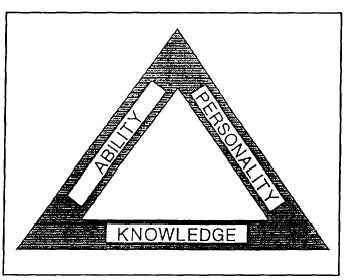| |
PROFESSIONAL PRECEPTS
If you were to observe efficient and
effective’tive instructors, you would see that
they have certain qualities in common.
These qualities provide a list of traits that
may serve as a set of ideals toward which
you may work as an instructor. These
traits also provide you with a basis for self-
evaluation and self-help. Each of these
traits belongs in one of three broad
categories:
k n o w l e d g e , a b i l i t y , or
personality.
Together,
these three
categories contain the professional qualities
of an effective and efficient instructor
(fig. 2-1).
Figure 2-1.-Professional precepts.
K N O W L E D G E
You must have many types of knowledge to be both efficient and effective as an instructor.
First, you must be thoroughly familiar with the subject you will be teaching. Generally, your
assignment to instructor duty indicates that your area “subject matter expert” in your area of
assignment. The formal training you have received in your rating coupled with your actual
work experience and on-the-job training will prove invaluable to you in your instructor
assignment. You may discover, however, that knowing the subject well enough to do the job
yourself is quite different from knowing how to teach others to do it. This latter area will bring
you your greatest challenges and rewards as an instructor.
You will need to know far more about the subject than you actually teach your students.
Only through practice, study, research, and keeping up with new developments can you attain
the vast store of knowledge required in your role as instructor. Avail yourself of every
opportunity to observe other instructors. Not only will that benefit you in learning more about
the subject matter, it will also expand your knowledge of instructional techniques.
You need to understand that you will be conducting training to meet the needs of the Navy,
not individual members. As discussed in chapter 1, the primary purpose of the Navy training
establishment is to provide the operational forces with trained personnel who can maintain a
high degree of fleet readiness.
Training and education have much in common, but they differ in important ways. Education
does not necessarily have a practical or defined goal; acquiring knowledge for its own sake is
a legitimate goal of education, but not of training. Training should accomplish at least three
things:
9 Develop knowledge, skills, and attitudes
9 Produce changes in behavior
_ Attain specific objectives
8
|

